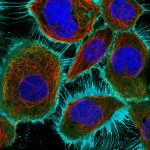Link to Pubmed [PMID] – 23331933
Traffic 2013 Apr;14(4):355-64
Eukaryotic cells with specialized functions often use and adapt common molecular machineries. Recent findings have highlighted that actin polymerization, contractile activity and membrane remodelling with exocytosis of internal compartments are required both for successful phagocytosis, the internalization of particulate material and for cytokinesis, the last step of cell division. Phagocytosis is induced by the triggering of specific cell surface receptors, which leads to membrane deformation, pseudopod extension and contraction to engulf particles. Cytokinesis relies on intense contractile activity and eventually leads to the physical scission of sister cells. In this review, shared features of signalling, cytoskeletal reorganization and vesicular trafficking used in both phagocytosis and cytokinesis will be described, but non-common mechanisms and questions that remain open in these dynamic areas of research are also highlighted.

